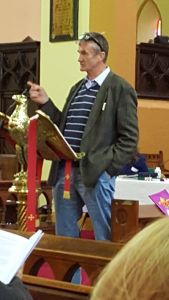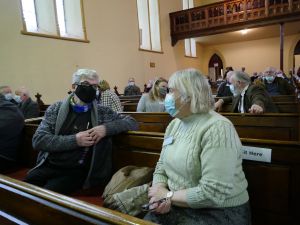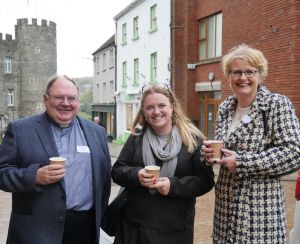Winter coats and facemasks were much in evidence at the Synod of the Church of Ireland Diocese of Cashel, Ferns & Ossory held in St Mary’s Church, Enniscorthy on Saturday afternoon, November 6th.
The Synod which was also broadcast online via webcam and followed all COVID-19 protocols began with a shortened Service of the Eucharist during which Bishop Michael Burrows’ delivered his Presidential Address as sermon. He took his theme of Greet one another with a holy kiss from St Paul’s letter to the Romans.
Lamenting the loss of ‘the tactile in our liturgy and relationships’ due to the pandemic he said that ‘circumstances have robbed us of something very important to our very being as gregarious beings made in the image of God’.
“There was a time when we spoke of the mental health value of giving and receiving a good hug,” he stated, also pointing out that the last time that he had shaken anyone’s hand in church was on the 1st March 2020.
“There is something profoundly sacramental about the tactile,” he continued.
“Handshakes don’t simply symbolize friendship but actually create and convey it. Similarly, the sacrament involving bread and wine doesn’t just symbolize the body and blood of Christ but actually conveys their benefits. When we cannot be tactile our means of understanding the sacramental world are diminished.”
Referring to the common cup as being ‘like being kissed by God in his love in the presence of others’ he looked forward to when it will be permitted again and referring to when ‘human hugs are stripped away’ he said that in this situation we have ‘this almost mystical experience that God is holding us’.
“I have every confidence,” he concluded, “that one day the common cup and kisses of peace will find their way back and we will relish them all the more. For the moment privation on the surface obliges us to mine for the pure gold in terms of how we connect as sacramental beings.”
There were two elections held, one of a lay member of Synod to serve on the Representative Body of the Church of Ireland for three years and the other to elect both a clerical and lay member of Synod to serve of the Church of Ireland Board of Education for three years.
William Galloway was elected to the former and the Reverend Trevor Sargent and Mrs Margaret Jacob to the latter.
Proposing the adoption of the Report of Diocesan Council came next. Mr Roger Boyd, a member of the Finance Committee, in his speech, spoke about the standard business tool, Key Performance Indicators (KPIs) and proposed the setting up of parish discussion groups.
 “We have huge finance issues tumbling down at us,” he said, “and a falling attendance and discussion groups would be a way of working together and being aware of what other parishes are doing related to finance.”
“We have huge finance issues tumbling down at us,” he said, “and a falling attendance and discussion groups would be a way of working together and being aware of what other parishes are doing related to finance.”
He went on to say that sooner or later we are all going to have to work together and to bit the bullet of smaller parishes being unable to pay a rector
The report was seconded by Canon Mark Hayden on behalf of the Very Reverend Tom Gordon.
The report was adopted by Council.
With no motions to discuss this year Synod then considered the first of three reports – the first of which was a collective one for Cashel, Waterford Lismore, Ossory and Leighlin and Ferns Boards of Education.
This was presented by principal Elma Cooke who spoke of the challenges that the pandemic created for teachers and praised parents and teachers for their resilience during this time. She also thanked the staff at Church House for their help when requested. She spoke, too, of the huge problems that the shortage of substitute teachers was creating for principals and of how she looked forward to singing again in school, to weekly assemblies, to playing together in the school yard and to pupils being able to travel, once again, to swimming lessons on a bus.
The report was seconded by the Reverend Nicola Halford who spoke also of the shortage of teachers and of the challenges that schools are still facing included those in the area of fundraising.
 Following a break for refreshment and to ventilate the building as per pandemic guidelines two more reports were presented to Synod – the Diocesan Board of Religious Education and the Safeguarding Report.
Following a break for refreshment and to ventilate the building as per pandemic guidelines two more reports were presented to Synod – the Diocesan Board of Religious Education and the Safeguarding Report.
Presenting the former Canon Patrick Harvey spoke of how the Senior Bishop’s Medal examinations had taken place online and how no annual national school festival services had taken place in 2021 and of how the board has a current surplus of savings.
Canon James Mulhall presented his Children’s Ministry and Safeguarding Reports. He spoke of developments like Muddy Church and Return To Church Resource Packs and of the Building Blocks and Children’s Ministry conferences coming up soon.
On the SGT front he was glad to report that all parishes in the diocese are compliant with Safeguarding legislation and flagged the fact that the triennial SGT audit will take place next year and that he will be visiting all unions/groups of parishes to make sure that noticeboards bear the necessary SGT information and that documentation is up to date and correctly kept. He spoke also of the need for compliance with Garda vetting requirements and of how the pandemic has limited his ability to provide in person training courses related to Safeguarding Trust. He thanked Diocesan Office staff for their help in filing all SGT documents there and the Bishop thanked Canon Mulhall for his considerable and valued work.
Six Diocesan Review Commission members then presented their Interim Report to Diocesan Synod 2021.
Chairperson Dorcas Collier spoke of how she hope that ‘the seeds sown today will germinate over time in our diocese’. Highlighting communication she spoke of how communication was a theme arising from all their hearings, of how a diocesan office/parish ‘them and us’ mindset needed to be dissolved, of how a communications team, policy, strategy and budget is needed and of how the Magazine should be further developed ‘to a publication that might be stocked by local news stands.’ Parish leaflets, text groups, group emails and Facebook pages were also suggested. “Communication is a valuable pastoral tool requiring a team approach,” she said.
Linda Rainsberry then spoke of their clergy survey which had a response rate of 65%. While most answers displayed conviction and depth of vocation and community building was identified as a priority emerging themes included an accepted need among clergy for change, for a better work/life balance, for the administration workload to be addressed and for more support from parish and diocese.
Eric Driver, Gillian Purser, the Reverend Canon Ian Cruickshank and Phyllis Grothier also spoke.
In relation to Diocesan Readers it was suggested that the role of warden of Readers could be further developed /supported and a resource library established.
Schools and faith-based organisations were also surveyed and a ‘where to from here’ suggestion made for a primary and secondary schools’ representative group to look at areas for deepening engagement with the church.
The work of the Youth Advisory Group was also focused on and the need for youth work in unions/groups of parishes to be consistent.
“At times there seems to be more strategy in maintaining church buildings than in developing the churches future through involvement of the youth,” the report stated.
The Mothers’ Union was also discussed as a valuable resource for clergy and diocese to tap inso. ‘If you have a good Mothers’ Union in a parish, you have a good parish’ it said.
The process of the appointment of clergy came under the DRC microscope also with the work of Diocesan and Parochial nominators explored.
Finance was the final topic of the report and attention was drawn to the immediate challenges facing the diocese, worsened by the pandemic, and to the age profile of parishioners where in two anonymous parishes it was shown that only 7% and 25% of parishioners were under 50 years of age.
The chairperson informed Synod that the next steps would be to further engage with clergy and meet parishioners with a view to presenting the DRC’s Final Report and Recommendations at Synod 2022.
The full interim report can be viewed on the Diocesan website’s homepage and you can send comment or question to the DRC now by emailing DiocesanReviewComission@gmailcom
An election then took place to fill the Very Reverend Tom Gordon’s place on the Commission following his resignation. The Reverend Robert Jones was elected.
Finally, the Diocesan Communications Officer Margaret Hawkins was invited to give an overview of communications matters and she highlighted the fact that it will take time for us all to recover from what is still a challenging pandemic and complimented the DRC on the scale of its valuable work. She also spoke also of how a communications policy has been developed ‘to build a confident church’ and the joy of launching a full colour Magazine to lift the spirits of the diocese and continue to tell its story well.
After closing words of thanks and encouragement from our Bishop the Synod ended with The Grace.
*Note – The Diocesan Magazine now has a dedicated page on the Diocesan website cashel.anglican.org/diocesanmagazine

